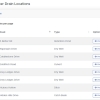
Municipal Separate Storm Sewer System (MS4) permits rest on a simple idea: you cannot manage what you have not first documented. The Environmental Protection Agency (EPA) defines an MS4 as any publicly owned system of drains, pipes, ditches, or similar conveyances that carries runoff to waters of the United States (epa.gov). Because every outfall is a potential pathway for pollutants, regulators require permittees to build and maintain an accurate, continually updated inventory of the entire network.
Under the Phase I and Phase II stormwater rules, each regulated MS4 must keep a map that, at a minimum, shows jurisdictional boundaries, every outfall, and the water body that receives each discharge. This obligation appears in 40 CFR 122.34(b)(3)(i)(A) and is echoed in EPA guidance, which stresses that the map must be available to inspectors and the public upon request (nacwa.org). Although the federal text stops with outfalls and receiving waters, it gives states latitude to broaden the scope “as needed to meet water-quality goals.” Most have done so.
Many contemporary general permits transform the basic map into a full asset register. New York’s 2023 General Permit GP-0-24-001, for instance, directs operators to prepare “comprehensive system mapping” in GIS format at 1:24 000 scale or finer. Within six months of the effective date, the dataset must already contain outfalls, interconnections, preliminary sewershed boundaries, pipe and open-channel attributes, culvert locations, and the number of connections to each catch basin or manhole. Land-use layers, surface-water classifications, impaired-water segments, and Total Maximum Daily Load (TMDL) watersheds follow in the first phase, with post-construction stormwater practices and municipal facilities added by year three (dec.ny.gov). Annual updates keep the map current and feed directly into illicit-discharge investigations, capital planning, and public outreach reports.
Although details differ by state, a compliant inventory today generally covers every physical component of the drainage system, the spatial context around it, and the attributes that influence maintenance and water-quality risk. In practical terms this means:
Geospatial coordinates and unique identifiers for each outfall, pipe segment, ditch reach, culvert, catch basin, manhole, headwall, and stormwater control measure.
Physical characteristics such as material, shape, diameter or dimensions, installation date, flow direction, and invert elevations for pipes and channels.
Sewershed or sub-catchment boundaries tied to each outfall, linked to population and land-use data so pollutant loads can be estimated.
Receiving-water information including classification, impairment status, and any applicable TMDL requirements.
Structural best-management practices and post-construction stormwater facilities with notes on design capacity, ownership, inspection findings, and maintenance dates.
Municipal yards, fleet-washing areas, salt and material storage sites, and other potential pollutant sources that fall under the Pollution Prevention/Good Housekeeping minimum control measure.
States frequently prescribe data formats, almost always GIS shapefiles or geodatabases, to ensure interoperability, and many, like New York, specify a mapping scale to guarantee positional accuracy (dec.ny.gov). Federal e-reporting rules further require that much of this information be submitted electronically during annual or biennial reporting cycles.
MS4 permits treat the map as a dynamic planning tool, not a one-time deliverable. Expansion of the built environment, replacement of aging pipes, and discovery of undocumented connections all trigger updates. Most permits require the inventory to be reviewed at least annually, with changes recorded before the next report is filed. Because illicit-discharge response depends on knowing every conduit between an upstream spill and a downstream outfall, municipalities that fall behind on updates often learn the hard way, during an enforcement inspection or a fish kill, that stale data can be as costly as no data at all.
A complete, well-maintained record does more than satisfy regulators; it lets local governments target rehabilitation dollars where they reduce risk the most, anticipate capacity shortfalls brought on by land-use changes, and defend capital-improvement budgets with evidence rather than conjecture. As asset-management software and hydraulic models evolve, the foundational layer they all share is still the humble MS4 map. Municipalities that invest early in data quality find that every subsequent initiative, from green-infrastructure siting to resilience planning, unfolds faster and at lower cost because the groundwork is already in place.
In short, MS4 regulations require a living, geo-referenced catalog of every component in the stormwater network, tied to water-quality and land-use data, and kept scrupulously current. Meeting that standard is an ongoing effort, but it is also the surest way to turn regulatory necessity into strategic advantage.
 Wetlands are often described as the kidneys of the watershed because they filter, slow, and transform the water that passes through them in ways that …
Wetlands are often described as the kidneys of the watershed because they filter, slow, and transform the water that passes through them in ways that …
 Field inspections of catch basins, manholes, culverts, and outfalls form the foundation of responsible stormwater management. These routine checks giv…
Field inspections of catch basins, manholes, culverts, and outfalls form the foundation of responsible stormwater management. These routine checks giv…
 Habitat disruption around drainage structures is often subtle at first, and many of the earliest signs tend to appear during ordinary field work rathe…
Habitat disruption around drainage structures is often subtle at first, and many of the earliest signs tend to appear during ordinary field work rathe…
 Harmful algal blooms have become one of the most pressing water quality problems in many regions, and their rise has been linked to a complicated blen…
Harmful algal blooms have become one of the most pressing water quality problems in many regions, and their rise has been linked to a complicated blen…
 The Salton Sea is one of California’s most unusual and tragic landscapes, a place shaped by accident, transformed by ambition, and ultimately pu…
The Salton Sea is one of California’s most unusual and tragic landscapes, a place shaped by accident, transformed by ambition, and ultimately pu…
 *The screenshots used in this article are from Roadwurx, an asset management software created for road maintenance departments. Managing a town’…
*The screenshots used in this article are from Roadwurx, an asset management software created for road maintenance departments. Managing a town’…